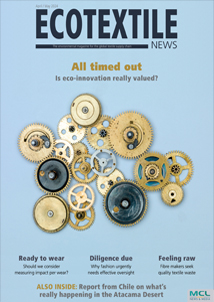WAKEFIELD - In an effort to broaden and share understanding about technological efforts to close the loop in the global textile industry, Ecotextile News is sharing with our subscribers some of the findings of the recently published report Closing the Loop. Here is the second article in this series in which we interviewed researchers in Australia who told us they had used ionic liquids – salt in a liquid state – to successfully separate polyester/cotton blended textiles, with polyester recovery rates claimed to be in the region of 99.5 per cent.
The researchers told us that, subsequently, work is now also underway to use this technology to spin new regenerated cotton fibres which – claim the researchers – are competitive with both viscose and lyocell.
The scientists involved in the work told us their work represented "a new environmentally friendly and convenient approach," and, crucially, also suggested that, "the material properties of the recovered polyester and cotton show that no significant differences can be seen between the recovered polymers."
Rasike De Silva, lead researcher on the project, told us: "We believe our breakthrough is game changing. From our research, we find that the separation of the polyester from the cotton is 99.5 per cent. We recover the polyester unmodified, and have been working on spinning a new regenerated cellulose fibre which is competitive with viscose and lyocell fibres.
"After recovering the undissolved polyester part, we have used the dissolved cotton to spin a new regenerated cellulose fibre. The cellulose fibre we spin, due to the non derivatising nature of the ionic liquid has a higher degree of polymerisation than the current commercially used viscose fibre.
This makes this fibre not only suitable for the textile industry but as a new precursor for carbon fibre. After the fibre regeneration, the ionic liquid can be recycled and reused by a simple evaporation method.
"Since our solvent is recyclable and reusable we anticipate that the cost should not be significantly higher and potentially lower than current viscose fibre formation."
Ionic liquids, said De Silva, mean polyester and cotton can be easily separated, adding: "The ionic liquid selectively dissolves the cotton component, with the added advantage that the liquid can then be recycled and reused.
"This cotton can then be regenerated into various forms, such as spun into fibres or cast as cellulose films, like cellophane." It was also claimed that the recovered polyester can also be recycled by melting and reshaping it into other forms, such as plastic bottles or fibres. Again, this opens the possibility extending closing the loop between the textile industry and other industries."











































